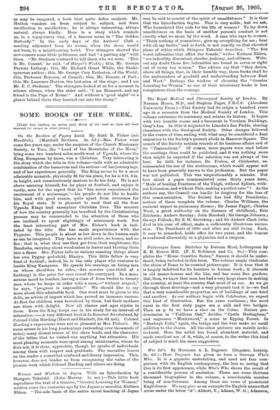The Royal Medical and Chirurgical Society of London. By Norman
Moore, M.D., and Stephen Paget, F.R.C.S. (Aberdeen University Press.)—This Society had its origin a hundred years ago in a secession from the Medical Society of London. This volume celebrates its centenary and relates its history. It began with two humble rooms and a basement in Verulam Buildings, Gray's Inn. In 1810 it migrated to Lincoln's Inn Fields, sharing chambers with the Geological Society. Other changes followed in the course of time, ending with what may be considered a final migration to the Society's present abode in Hanover Square. The annals of the Society contain records of its business affairs and of its "Transactions." Of course, more papers were read before the meetings than could be published, and it was nothing more than might be expected if the selection was not always of the best. In 1823, for instance, Dr. Forbes, of Chichester, re- commended the use of the stethoscope, which would appear not to have been generally known to the profession. But the paper was not published. This was unquestionably a mistake. But, how about a paper communicated some thirty years later, "Mode of healing Fractures of the Thigh, without Splints, with- out Extension, and without Pain, making a perfect cure " ? As the authors say, the Council can hardly be forgiven for the loss of this communication. The Society has had fifty Presidents; notices of these complete the volume. Charles Williams, the eminent expert in pulmonary disease ; Sir James Paget; Charles West, a great authority on the diseases of childhood; Eric Erichsen ; Andrew Barclay ; John Marshall; Sir George Johnson ; George Pollock; Sir E. H. Steveking ; and Sir Andrew Clark (who died in his year of office), make a sufficiently illustrious succes- sion. The Presidents of 1890 and after are still living. Each, it may be remarked, holds office for two years, and, the honour is conferred alternately on a physician and a surgeon.


































 Previous page
Previous page